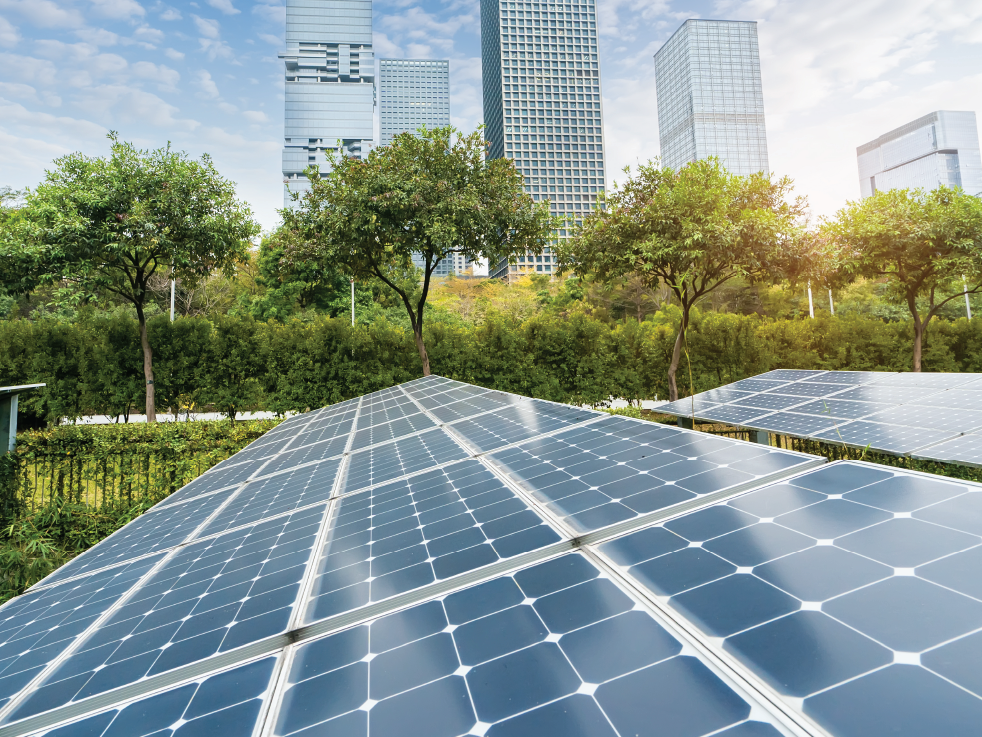Your customers care about decarbonization. See why you should, too:
Make an impact and zero in on sustainability.

You may have heard the term decarbonization being thrown around as a popular buzzword. But its importance extends far beyond being a trendy term.
Decarbonization is the reduction of carbon dioxide emissions and a commitment to greater sustainability. Many leading organizations set their own decarbonization goals to help counteract climate change, enabling renewable energy, better health, and environmental stability.
Within this initiative, infrastructure tends to be front and center due to the sheer amount of energy it consumes. Think of just how much energy goes into the cooling, powering, and backup of a data center!
Decarbonization is a classic case of doing well by doing good. Many customers want to purchase sustainable products and support businesses with low carbon footprints. And consumers aren’t the only ones who care — employees hold their employers to a higher standard as well, considering a company’s sustainability when choosing a job in today’s market. Perceived sustainability and decarbonization efforts can affect your entire brand value.
“62% of organizations have defined decarbonization goals — more than one-third of these have set specific target dates,” according to the State of Decarbonization 2025 survey by EnergyCAP. “Compared to last year’s survey, goals have increased by 7 percentage points, proving more organizations are joining the decarbonization movement.”
Partnering for a better future
The path to decarbonization is not a one-size-fits-all journey. So, where can you start? One of the most important steps you can take is to partner with future-focused organizations dedicated to decarbonization and sustainability goals. Explore how some of SHI’s partners are going green for a better tomorrow.
AMD
AMD focuses on advancing environmental sustainability across their operations, supply chain, and products. They aim for a 30x increase in energy efficiency for processors and accelerators by 2025 and a 50% absolute reduction in Scopes 1 and 2 greenhouse gas (GHG) emissions from their operations by 2030. “By understanding our customers’ computing needs, together we can apply AMD technology to tackle tough challenges like advancing climate research, electrification of vehicles, and power grid resilience,” shared AMD.
Apple
Apple plans to be carbon neutral across their entire carbon footprint by 2030. Their strategy includes using recycled and renewable materials, sourcing manufacturing electricity from renewable sources, and prioritizing low-carbon shipping methods. More than 97% of Apple’s packaging is now fiber‑based, with 320+ of their suppliers already on board to using 100% renewable electricity by 2030. “To catalyze efforts to reach a 1.5° C pathway, Apple is scaling up carbon removal solutions, beginning with those that are available today, while exploring the solutions of the future,” according to Apple’s Environmental Progress Report.
Cisco
Cisco set a target to achieve net-zero GHG emissions across their value chain by 2040. By 2025, their goal is for all new products and packaging to incorporate Circular Design Principles. The Cisco Foundation has committed to investing $100 million in climate solutions over the next decade. “By pursuing what’s possible, we can accelerate the transition into the digital age while maintaining the health of the planet — and a climate future we all need and desire for future generations to come,” said Cisco.
Dell Technologies
Dell is committed to achieving net-zero greenhouse gas emissions across Scopes 1, 2, and 3 by 2050. By 2030, they aim to source 75% of their electricity from renewable sources across all Dell facilities and reduce Scope 3 emissions significantly. Dell also focuses on a circular economy, aiming for all packaging to be made from recycled or renewable materials by 2030. “We are advancing sustainable computing to help you transform your organization in a low-carbon economy,” shared Dell.
HP
HP aims to reduce value chain GHG emissions by 50% by 2030 (compared to 2019), and achieve net-zero emissions by 2040. Their strategy includes giving back more to forests than they take and innovating products and services for a circular economy. “To catalyze decarbonization within our supply chain, we work with suppliers to set science-based targets, implement energy management systems to increase efficiency, and utilize renewable electricity,” reported HP.
IBM
IBM has a long-standing commitment to sustainability, dating back to the 1970s. They strive to procure 75% of their electricity from renewable sources by 2025 and 90% by 2030; additionally, IBM plans to reach net-zero operational GHG emissions by 2030. IBM also focuses on conservation, biodiversity, pollution prevention, and waste management, including reducing water withdrawals and eliminating nonessential, single-use plastics from cafeteria operations. “The overarching goal? Create better pathways to reducing the impact on our planet and making it a safer place for all living things,” explained IBM.
Intel
Intel set a goal to achieve net-zero Scopes 1 and 2 greenhouse gas emissions by 2040 and net-zero upstream Scope 3 emissions by 2050. They focus on improving energy efficiency with each new product generation and leveraging their experience and impact to promote sustainable computing. “We know that protecting our planet requires immediate action and new thinking,” said Intel. They are committed to “working with customers and industry partners to create solutions that reduce the greenhouse gas footprint of the entire technology ecosystem.”
Lenovo
Lenovo is committed to reaching net-zero greenhouse gas emissions by 2050. They aim to remove 1 million tons of GHG emissions from their supply chain by fiscal year 2025/2026 and ensure 100% of PC products contain post-consumer recycled materials by the same timeframe. “By working with the Science Based Targets initiative (SBTi) and aligning to their Net-Zero Standard (the world’s first), Lenovo is taking a scientific, collaborative, and accountable approach to reducing emissions.”
Microsoft
Microsoft aims to be carbon negative by 2030 and remove all historical emissions by 2050. They also plan to achieve zero waste and be water positive, replenishing more water than they consume, by 2030. To protect and preserve ecosystems, Microsoft plans to protect more land than they use by 2025. Microsoft created a $1 billion Climate Innovation Fund to advance the global development of carbon reduction and removal technologies. Microsoft is also investing in AI-based solutions: “As the world enters a new era of AI, there is both an opportunity and an urgent need to focus the abilities of AI on accelerating sustainability.”
NVIDIA
NVIDIA’s sustainability strategy leverages AI and accelerated computing to set new standards for environmental responsibility. The company aims to increase energy efficiency significantly, and has made progress by using 76% renewable electricity and achieving 60%+ Scope 3 category 1 emissions covered in supplier engagement in FY 2024. “We’re working with companies worldwide to apply AI’s revolutionary capabilities to save energy and adapt to climate change,” said NVIDIA.
Pure Storage
Pure Storage focuses on operational sustainability and climate disclosure, including third-party verification of GHG emissions and increasing renewable electricity use. They aim to reduce energy and emissions in data centers globally by upwards of 20%. “Pure Storage believes sustainable data storage technology is necessary to help address climate change. We aim to do this by designing and delivering solutions for our customers that use less power and space, and reduce e-waste.”
Eco-friendly IT
When you work with SHI and our partners, we consider not only your future success but also the successful preservation of the environment.
Promoting a sustainable future is an essential part of our overall business strategy and extends to our service offerings. For instance, you can take advantage of SHI’s sustainability solutions, which include asset recovery, asset disposal, e-waste recycling, hardware remarketing, and hardware redeployment. We are here to help you reduce, reuse, and recycle your equipment to minimize your carbon footprint.
SHI believes in sustainable innovation, delivering solutions to help reduce energy consumption and environmental impact. Our experts provide clear, actionable, and proven recommendations in four key areas:
- Sustainable end-to-end data center solutions
- Cloud workload migration and optimization
- Responsible IT asset management
- Infrastructure solutions that enable circularity
Discover more about our sustainability management approach, milestones, certifications, and science-based climate targets in SHI’s Sustainability and Action Report. Our climate and environmental priorities include decarbonization and energy efficiency, waste management and recycling, water conservation, and circularity.
Our eco-friendly solutions can kickstart your journey in tandem with our extensive partner ecosystem and their efforts toward a more sustainable future. If you want to set and meet your own decarbonization goals, connect with our specialists to solve what’s next.




